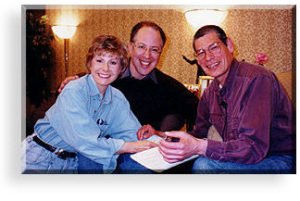In 2001, I was invited to deliver the opening keynote speech at the Toastmasters International Convention. In this 10-segment series, you view the anatomy of a keynote presentation. 10 of 10.
“This is your homework assignment. (Now I would call it a Frippercize.) I want you to sit down with some of your other Toastmaster friends and tape-record all the stories you’ve never told in speeches. Take an incident in your life, start at the beginning, and go all the way through. I have two ‘hanging-around buddies’ in San Francisco: John Cantu, comedy legend, and David Garfinkel, genius copywriter. David would also love to write film scripts. I like to think of myself as a charismatic keynoter.
“We call ourselves the ‘Three Musketeers’ of speech writing. A couple of years ago, on December 26th, the three of us got together for our annual holiday morning coffee and lunch. This was the first social event that John Cantu had had since his recent operation to have a large cancerous tumor removed. And three minutes into his talking about the symptoms of the cancer and how it got started, I said, ‘John, hang on. This is going to be a speech one day. Let me get the tape recorder.’”
Yes, I know, we no longer use tape recorders.
Lesson: Record conversations with interesting friends, especially when they are telling stories of life-changing experiences. You never know what may happen.
“As John was telling us the story, from the beginning and all the way through, it was funny; it was poignant; it was dramatic. We recorded all of it. We then had the entire two and a half hours transcribed. Not only did this end up being a talk that John delivered called, “Laughing all the Way to the Hospital,” we also turned it into a seminar and re-enacted it for our other speaker friends.
“In other words, record everything, but also hang around with people who have different strengths. I see everything as a potential speech. Cantu saw everything as funny, even the cancer operation, and Garfinkel sees everything as a made-for-television movie. Do that with your friends.”
Lesson: Collaborate with friends from other disciplines.
“Now you have your structure. You have your variety of openings. You have your material. You make your stories come alive. Of course, there’s nothing like stage time when it comes to improving your delivery. Pause. Have variety. Of course, whenever we talk about delivery, especially when we think of timing, you always think of whom? Jack Benny. Exactly, Jim Cathcart, you’re smart. And you didn’t even know what I was going to do. Would you like to hear what Jack Benny says about timing?”
Play the video to hear the voice of Jack Benny.
Larry Wilde: “What exactly is timing?”
Jack Benny: “Well, sometimes I think that I’ve been given a lot more credit than I merit in that, because every good comedian has to have, right off the reel, good timing. Otherwise, he can’t even appear any place. Without timing you can’t appear any place. I think the reason other comedians and maybe the public, who is gradually getting to know about timing, they know the words now, is because I talk very slowly. And I talk almost like I’m talking to you now. You know, I might hesitate. I might think. I might do things that would be, everybody has a feeling at home watching television, or when they come to a theater, that I’m addressing him or her individually.”
Note: This last sentence could use a little cleaning up. However, if you listen to the embedded video, it is an exact transcription.
Lesson: A speech is not a conversation. Just as with comedy, however, it needs to sound conversational.
Jack Benny: “They feel that I’m doing it for them, and it’s because I talk slowly, and I make it a point to talk like I would in a room with fellas now. They think my timing is great for that reason. Now other people have great timing, but they talk very fast. Now it would be very tough for them to talk slowly. It’d be tough for me to talk fast. Talk about fine timing, George Burns, who times similarly, certainly has a similar timing to mine.”
Lesson: Don’t talk so fast that your audience can’t digest what you are saying.
Larry Wilde: “Is it possible to define timing?”
Jack Benny: “It’s tough to define it, isn’t it? Because I rarely use the word pause, rhythm. You see, my pause is fortunate. Fortunately, it even went over in radio where you couldn’t see me. The audience felt the pauses, you know?”
Lesson: The written word is for the eye. The spoken word is for the rhythm.
“Just a couple of other ideas from your diagram to think about. It says, ‘Do not be the hero of all your stories.’ Tell stories that you might have witnessed, seen, heard, and learned. Remember, don’t be the hero of all your stories.
“A few years ago, I was speaking for State Farm when a woman came up to me and said, ‘I hate motivational speakers, but they made me come to hear you, and you were quite good.’
“I asked, ‘Why do you hate motivational speakers?’ She said, ‘Because all they ever do is tell you how good they are.’ Bill Gove, Golden Gavel winner, said, ‘Very often a speaker gives you the impression they came down from the mountaintop with the tablets from God with the answers to life. Where is the motivation for your audience if you give them the impression that you always knew what you were talking about?’
“The next idea is the ‘I-you ratio.’ How do you bring the audience into your speech? I hope you have noticed that there have been many times when I bring you into the conversation. Think of this opening line. Newt Gingrich said, ‘If you were born today, you would already owe $186,000 to pay off your share of the natural debt.’ Twice he’s talking about you. Anytime you say ‘imagine,’ you bring people into your speech. Always look at how they are integrated into your remarks.
“We’ve been in this room a long time. I hope my remarks, my ideas have been helpful to you. If you’d like more, go to fripp.com/blog There are hundreds of free articles on speaking. Check out Great Comedians Talk About Comedy.
“What can I say? When I first turned up at Cable Car Toastmasters in 1975, who would have thought I’d one day have the opportunity to open an international convention with a kind and generous audience? You know, it never ceases to amaze me that intelligent, well-educated, and ambitious people frequently overlook developing the number one skill that is guaranteed to position them ahead of the crowd. Namely, the ability to stand up and speak eloquently with confidence.
“Perhaps it is because, as Jack Lemmon said, ‘It takes the nerve of a bullfighter, the energy of a nightclub host, and the concentration of a Buddhist monk.’ And let’s face it, it doesn’t hurt to join Toastmasters. Thank you.”
Lesson: This is an example of the circular technique

Note: The late John Cantu was a comedy legend who founded the Holy City Zoo comedy club where many of the comedy greats got their start. Robin Williams, Kevin Bacon, A. Whitney Brown, Dana Carvey, Ellen DeGeneres, Nora Dunn, Will Durst, Kevin Meaney, Kevin Nealon, Paula Poundstone, Rob Schneider, and Bobby Slayton.
Great Comedians Talk About Comedy
Does your presentation deserve the very best? Let’s talk.
Need help for you or your team on improving important conversations and presentations? The Fripp Customized Approach will work for you. Contact Fripp today!

